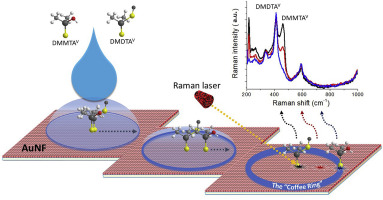当前位置:
X-MOL 学术
›
Anal. Chim. Acta
›
论文详情
Our official English website, www.x-mol.net, welcomes your feedback! (Note: you will need to create a separate account there.)
Speciation of Thioarsenicals through Application of Coffee Ring Effect on Gold Nanofilm and Surface-Enhanced Raman Spectroscopy
Analytica Chimica Acta ( IF 6.2 ) Pub Date : 2020-04-01 , DOI: 10.1016/j.aca.2020.01.042 Valery Liamtsau , Changjun Fan , Guangliang Liu , Anthony J. McGoron , Yong Cai
Analytica Chimica Acta ( IF 6.2 ) Pub Date : 2020-04-01 , DOI: 10.1016/j.aca.2020.01.042 Valery Liamtsau , Changjun Fan , Guangliang Liu , Anthony J. McGoron , Yong Cai

|
Thioarsenicals, such as dimethylmonothioarsinic acid (DMMTAV) and dimethyldithioarsinic acid (DMDTAV), have been increasingly discovered as important arsenic metabolites, yet analysis of these unstable arsenic species remains a challenging task. A method based on surface-enhanced Raman spectroscopy (SERS) detection in combination with the coffee ringeffect for separation is expected to be particularly useful for analysis of thioarsenicals, thanks to minimal sample pretreatment and unique fingerprint Raman identification. Such a method would offer an alternative approach that overcomes limitations of conventional arsenic speciation techniques based on high performance liquid chromatography separation and mass spectrometry detection. A novel analytical method based on combination of the coffee ringeffect and SERS was developed for the speciation of thiolated arsenicals. A gold nanofilm (AuNF) was employed not only as a SERS substrate, but also as a platform for the separation of thioarsenicals. Once a drop of the thioarsenicals solution was placed onto the AuNF and evaporation of the solvent and the ring stamp formation onto AuNF began, the SERS signal intensity substantially increased from center to edge regions of the evaporated droplet due to the presence of the coffee ring effect. Through calculating the pKa's of DMMTAV and DMDTAV and accordingly manipulating the chemical environment, separation of these thioarsenicals was realized as they travelled different distances during the development of the coffee ring. The migration distances of individual species were influenced by a radial outward flow of a solute, the thioarsenicals-AuNF interactions and a thermally induced Marangoni flow. The separation of DMMTAV (center) and DMDTAV (edge) on the coffee ring, in combination with fingerprint SERS spectra, enables the identification of these thioarsenicals by this AuNF-based coffee ring effect-SERS method.
中文翻译:

通过咖啡环效应在金纳米膜上的应用和表面增强拉曼光谱的硫砷化物形态
硫砷化合物,如二甲基单硫砷酸 (DMMTAV) 和二甲基二硫砷酸 (DMDTAV),越来越多地被发现作为重要的砷代谢物,但对这些不稳定的砷种类的分析仍然是一项具有挑战性的任务。由于最少的样品预处理和独特的指纹拉曼识别,基于表面增强拉曼光谱 (SERS) 检测结合咖啡环效应进行分离的方法有望对硫砷化合物的分析特别有用。这种方法将提供一种替代方法,克服基于高效液相色谱分离和质谱检测的传统砷形态技术的局限性。开发了一种基于咖啡环效应和 SERS 组合的新型分析方法,用于硫醇化砷的形态形成。金纳米膜 (AuNF) 不仅用作 SERS 基底,而且用作分离硫砷化物的平台。一旦将一滴硫砷溶液置于 AuNF 上并开始蒸发溶剂和在 AuNF 上形成环印章,由于咖啡环效应的存在,SERS 信号强度从蒸发液滴的中心到边缘区域显着增加. 通过计算 DMMTAV 和 DMDTAV 的 pKa 值并相应地操纵化学环境,这些硫砷化合物在咖啡环形成过程中随着它们移动的距离不同,实现了分离。单个物种的迁移距离受到溶质的径向向外流动、硫砷-AuNF 相互作用和热诱导的 Marangoni 流动的影响。咖啡环上 DMMTAV(中心)和 DMDTAV(边缘)的分离,结合指纹 SERS 光谱,可以通过这种基于 AuNF 的咖啡环效应 SERS 方法识别这些硫砷化合物。
更新日期:2020-04-01
中文翻译:

通过咖啡环效应在金纳米膜上的应用和表面增强拉曼光谱的硫砷化物形态
硫砷化合物,如二甲基单硫砷酸 (DMMTAV) 和二甲基二硫砷酸 (DMDTAV),越来越多地被发现作为重要的砷代谢物,但对这些不稳定的砷种类的分析仍然是一项具有挑战性的任务。由于最少的样品预处理和独特的指纹拉曼识别,基于表面增强拉曼光谱 (SERS) 检测结合咖啡环效应进行分离的方法有望对硫砷化合物的分析特别有用。这种方法将提供一种替代方法,克服基于高效液相色谱分离和质谱检测的传统砷形态技术的局限性。开发了一种基于咖啡环效应和 SERS 组合的新型分析方法,用于硫醇化砷的形态形成。金纳米膜 (AuNF) 不仅用作 SERS 基底,而且用作分离硫砷化物的平台。一旦将一滴硫砷溶液置于 AuNF 上并开始蒸发溶剂和在 AuNF 上形成环印章,由于咖啡环效应的存在,SERS 信号强度从蒸发液滴的中心到边缘区域显着增加. 通过计算 DMMTAV 和 DMDTAV 的 pKa 值并相应地操纵化学环境,这些硫砷化合物在咖啡环形成过程中随着它们移动的距离不同,实现了分离。单个物种的迁移距离受到溶质的径向向外流动、硫砷-AuNF 相互作用和热诱导的 Marangoni 流动的影响。咖啡环上 DMMTAV(中心)和 DMDTAV(边缘)的分离,结合指纹 SERS 光谱,可以通过这种基于 AuNF 的咖啡环效应 SERS 方法识别这些硫砷化合物。


























 京公网安备 11010802027423号
京公网安备 11010802027423号